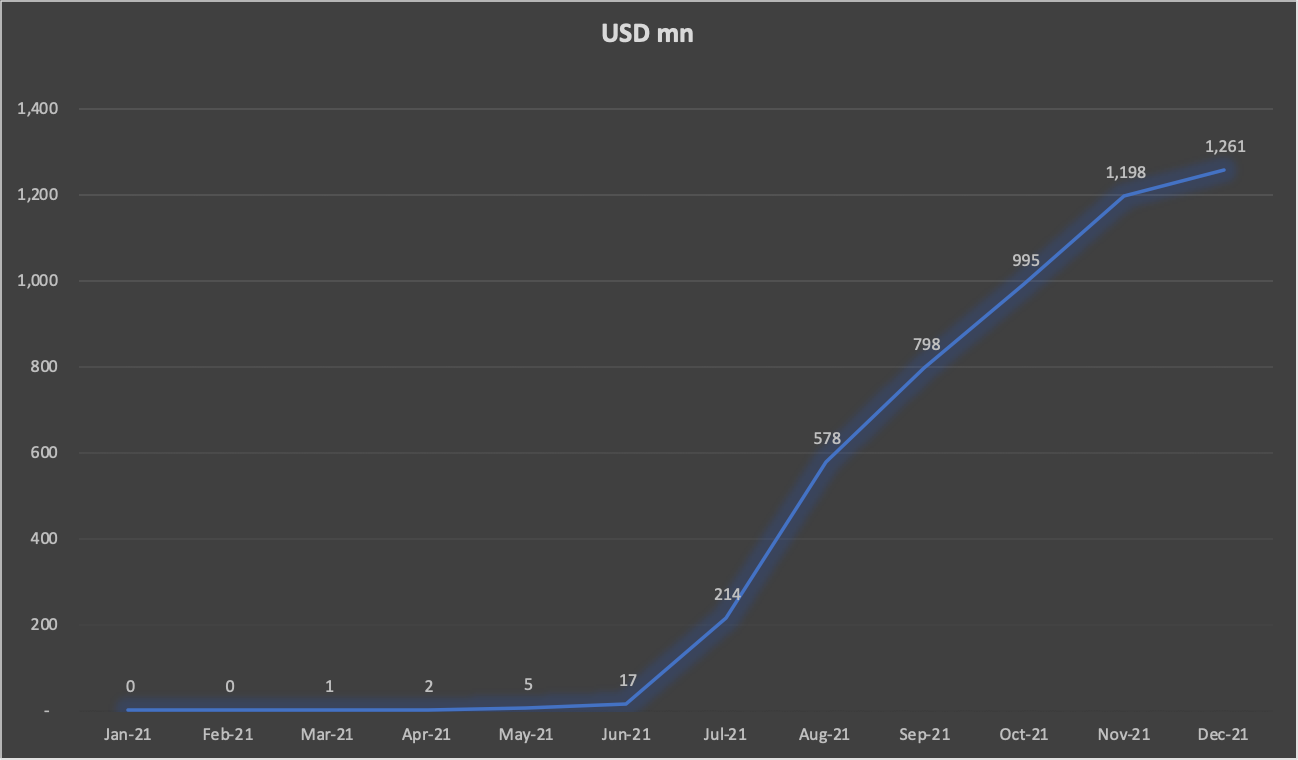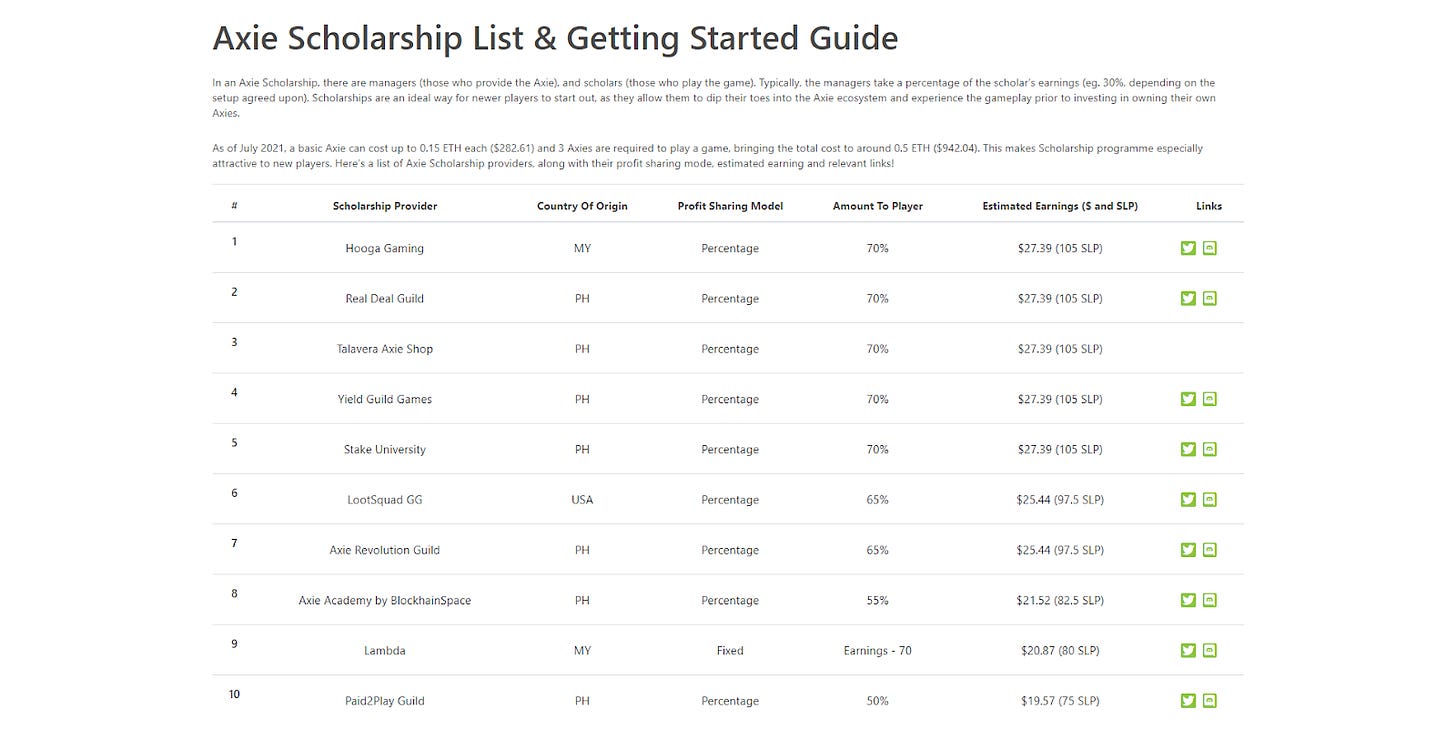Crypto #3 - To Axie Infinity and Beyond...
Web3 cometh.....
I will encourage you to read this post on the web. It is apparently too long for email and will get truncated so you can read it in full on the website here.
Last post of the year.
Today, let’s take a look at a crypto company. For now, lets just look at its financial performance. Here are its cumulative revenues for this year:
It started Jan 21 at $103K in revenues. It has ended December with $62mn, with a peak monthly revenue of of $365mn in Aug 2021. It’s annual revenues will be in excess of $1.2bn.
If these were annual cumulative numbers for any business, VCs will be salivating. 200x in 3 years - this is the reaction.
200x in 3 months? I know at least one who will collapse in a 90 minute orgasm dreaming of bags of dollars they will take home while simultaneously frothing at the mouth and displaying uncontrolled incontinence at the other end.
How is that for a rocketship? Before we go deeper though, I would recommend you take a look at this documentary - Play-to Earn. Watch it if you can.
Axie Infinity is a Pokémon-like game built on the Ethereum blockchain in which people buy digital pets, called Axies, as NFTs, and breed, battle, and trade them. It’s cute. It’s unassuming. This is what they look like:
Now, let’s be clear - this cuteness hides a business whose growth can only be described as absurd. Axie is integrating vertically in an ecosystem that encourages composition of modularity and looks askance at those who squat on virgin digital (metaverse?) real estate. In its whitepaper, Axie developer Sky Mavis explicitly says, “You can think of Axie as a nation with a real economy.” Along the way, this company is likely going to define what working in the “metaverse” means. Are we all going to be breeding digital cats in our Ready-Player-One-esque immersion rigs?
Now, the smarter ones among us are going to go back to the chart and say that hey - the numbers are falling since August - and you would be right. While those numbers are salivation inducing, they’re actually not the biggest or fastest ever in gaming. The rare gaming mega-hit gets really big, really fast. Many fade away just as quickly. What makes Axie unique is that its plans are much larger and include vertical integration, decentralization, aggregation (yes, as much sense as those two words make one after another) and literal world-building. From the video linked above:
Scores of people in the Philippines and Vietnam have quit their jobs and make a better living playing Axie for hours every day. They earn Smooth Love Potion (SLP)1, a token earned through Axie gameplay that can be exchanged for fiat, which in turn can be used to pay for food, shelter, medical bills, and all of the other things needed to survive. Some people who were previously making $5 per day now make $20.
More importantly, Axie is delivering some important insights on crypto’s long term assumptions:
NFTs’ success is not dependent on high ticket arty-farty stuff.
Mango people can become big in crypto via abstractions - in this case a video game.
Crypto can create new economic opportunities crossing borders seamlessly. It is delivering on the promise of a more level playing field while also capturing economic value.
Network effects + fast growing business = Moats!!
One of the main weak points of crypto so far has been the claim that it has no real-world value or application, but Axie makes you revisit the very concept of real-world value. Here, the value comes from providing income, and opportunity to the players directly. A typical game would spend millions of dollars on marketing and keep the majority of profits to itself; Axie spends nothing on marketing, but lets players keep most of the value created. That is something unseen so far. You don’t need to be a whale with 6 screens to benefit from crypto.
And that’s just its first act. Axie will likely reshape work and build the most valuable IP in history, all owned by the players themselves. Chris Dixon’s famously said that “the next big thing will start out looking like a toy.” Axie certainly fits the bill.
In Nov 2017 - Cryptokitties had me rolling my eyes - I was sure it was a fad. and while I was judging people with no lives and too much time on their hands, a Vietnamese guy was thinking - “What if I could combine the gameplay of pokemon with the ownership and breeding of Cryptokitties?”
Nguyen ended up creating “a Pokémon-inspired universe where anyone can earn tokens through skilled gameplay and contributions to the ecosystem. Players can battle, collect, raise, and build a land-based kingdom for their pets.” So, instead of owning Pokemon cards, players buy their Axies in the form of NFTs, and they can earn and exchange the tokens for local currency, not being limited to appreciation of NFTs.
More importantly, Axie offers a lesson in community building that applies to most platforms. One of the challenges that platforms (including games and new crypto projects both) face is that they can attract a lot of hype and fanfare, generate a ton of revenue quickly, and then die off just as fast. Here, they managed to attract a core of true believers and worked out the kinks before they became really big.
Axie’s growth is objectively impressive, but it’s all the more impressive when you realize how much work is involved in simply getting on-boarded. The Axie team published a Getting Started Guide that takes six unfamiliar steps to even get to “learn how to play.”
Just getting started requires acquiring ETH, signing up for a MetaMask wallet, transferring ETH, downloading another wallet (Axie’s own Ronin wallet), transferring ETH again, acquiring NFTs on Axie’s own NFT marketplace, logging in with MetaMask, and then finally downloading the application itself, on desktop or mobile. To start playing, you need three Axies. You can acquire Axies in the Marketplace, where the cheapest of the ~100k odd Axies available is going for 0.1 ETH, or $195. And yet, 600k players. Somewhere, an Amazon PM is going “dayum…”
But we are not done yet - to join the community, you need to download Discord, create an account, enter the #welcome room, verify your phone number, agree to community standards, and type “?join Trainers” to get into the main rooms. None of this is necessarily smooth or easy.
As a writer, it’s poor form to walk you through that whole process here. Even just reading all of that seems like a lot. I probably lost a few of you. Imagine what it’s like to actually do all of the steps. Yet despite all of the hurdles, Axie is growing like crazy. There must be something magical waiting beyond the onboarding. Yup - Play to earn.
I recently wrote a big piece on the Video Games Industry. Some of the most successful games of late are Free-to-Play games. In this model, the publisher gives away the full game for free and makes money by selling virtual in-game items like skins and emotes. In a thread on video games, music, and NFTs, Chris Dixon pointed out how successful this model has been for the video game industry:

Let’s take Fortnite as an example. In Fortnite, you can start playing the game with a generic character for free, but if you want to upgrade to play as, say, Deadpool, you can buy the Deadpool skin from Epic Games via the Item Shop using Fortnite’s own in-game currency, V-Bucks.
Free-to-Play is one hell of a business model. in 2021, Fortnite will generate ~$8bn of revenues. All from digital shirts. WTF!
However, there are dark sides to this. two of the fastest growing games ever are Ni No Kuni and Pokemon Go. On paper, they are Free-to-Play games. In reality, they are Pay-to-Win games.
The Reddit thread on Ni No Kuni showcases the issues with the model:
“It's one of those MMOs that you will be stuck at some level and can't progress because of the exp and the gear and pet gacha look like a massive p2w, you rarely get the currency at all.”
Essentially, pay up or get stuck.
But questionable moral choices notwithstanding, there is way too much leakage in the games. As an example, Roblox can also allow you to make money2 by allowing folks to develop for the platform. There is enough of an in-game marketplace to allow someone to make a living off it. However, not more than 30% goes to developers. From Robolox’s own data - 27% of every dollar spent via Robux goes to developers, 25% to app stores, 12% to invest in and support the platform, and 27% to Roblox itself.

Anyone remember Gold Farming3? In the Netflix Show Ozark, Marty Byrde’s Son decides he will also launder money like dad, but sticks to gold farming. As described in this New York Times piece, Chinese workers would spend 12 hours per day for $0.30 cents per hour collecting gold and other digital assets in World of Warcraft. Their bosses made $3 for selling those coins to an online retailer, and the retailer made as much as $20 selling them to American or European players who didn’t want to spend all that time themselves. Now, if only the poor unwashed masses could make this money for themselves….
Unlike a traditional Free-to-Play model, in which developers sell to players, or a Roblox-like model, in which the developer intermediates transactions, Axie Infinity is player-to-player.
Axie has a 100% player-owned, real money economy. Rather than selling game items or copies, the developers of the game focus on growing the player to player economy and take small fees to monetize. Axies are created by players using in-game resources (SLP & AXS) and sold to new/other players. The holders of the AXS token are the government that receives tax revenues. Game resources and items are tokenized, meaning they can be sold to anyone, anywhere on open peer-to-peer markets.
Axie is explicitly not Free-to-Play. To start playing Axie Infinity, you need to turn real money into ETH in order to buy three Axies, the cheapest of which will cost you $195 at today’s prices. But instead of paying a developer for the right to essentially rent that avatar (or Land, or Item, or Bundle), you own it. And by playing the game, you own the game, and can make decisions on its future development or complete quests to earn real income. When new players enter, they don’t buy Axies from Sky Mavis or Axie Infinity; they buy them from other players, who either sell their own Axies or breed new ones. Players sell entry tickets to the universe.
The Axie protocol generates revenue by taking a 4.25% fee when players buy and sell Axie NFTs in its marketplace, and by charging fees for breeding Axies to create new ones in the form of its tokens, Axie Infinity Shards (AXS) and Smooth Love Potion (SLP)4. AXS and SLP are denominated in ETH, which has been cut by more than half since May; Axie has grown USD revenue even in the face of falling ETH prices.
There are more than 800k players globally - almost 60% in the philippines. The Axie protocol takes a 4.25% commission on each trade on the marketplace and a fee (in the form of AXS and SLP tokens) when new Axies are bred.
Unlike traditional models, in Axie’s Play-to-Earn model, 95% of the revenue goes to the players. That is a genuine innovation.
Here’s how Axie works (and if it sounds like greek to you, don't worry, I am mostly in the same boat as you. Now, I am going to shamelessly copy from someone who has written about it better than I could:
Each Axie has different stats -- Health, Morale, Skill, and Speed -- that give them strengths and weaknesses in battles.
Adding some complexity is the fact that each Axie’s stats are dependent on its class -- Beast, Reptile, Aquatic, Bug, Plant, Bird, Moon, Nut, Star -- and body parts -- eyes, ears, horns, mouth, back, and tail. Some classes are better at attacking, and some are better at taking damage; Axies operate in teams of three, so part of the skill comes in configuring teams with a mix of “attackers” and “tanks,” optimally constructed to fight certain configurations of other teams’ Axies.
In the battle, the two sides take turns using their Axies’ cards to attack the other side. Cards might have different impacts depending on the class of Axie you’re using it against -- for example, a Bird card used to attack a Beast Axie will cause an additional 15% damage. Each pair of classes has such a relationship with the others:
As Howard mentioned, this is a strategic game. It depends more on skill than luck of the draw. If you want to go deeper on the game itself, start here. For our purposes, what’s most interesting is that by winning PvP and PvE battles and completing Daily Quests, players can earn Smooth Love Potion (SLP) tokens, so named because they’re required to breed new Axies.
So, if you are a smart guy, the opportunities are endless. Assuming you are able to pay the $200 or so entry fees. During COVID, when many people in Philippines lost their jobs, they turned to Axie Infinity to make ends meet.
There’s even a documentary that I linked to above - Play-to-Earn, about the phenomenon:
In a Filipino town called Cabanatuan City, a 75-year-old couple named Lolo and Lola Silverio, play Axie to supplement the $5-6 they make from their small shop per day and pay for their medical expenses. At some level it is deeply sad. At another, it is mind-blowing.
Now, the more eagle-eyed among you might ask, “How could Lolo and Lola afford to buy the three Axies required to get started? Don’t they cost at least $195?”
I’m glad you asked. The answer - Scholarships. These programs have sprung up across the globe to provide aspiring players with their own teams of Axies. The scholarship essentially rents players Axies, and gets paid back through a revenue share from SLP proceeds.
The documentary highlights Yield Guild Games, which provides scholarships globally, for Axie Infinity and emerging games like The Sandbox and League of Kingdoms. Think about it - People send real, well-formatted resumes to Yield Guild and other scholarship programs every day, showing off not just their professional credentials, but their gaming experience as well.
This is Insane. Proceeds from NFT auctions are going to scholarships to support people in developing countries who want to earn a living by playing a Free-to-Earn, NFT-based game in the Metaverse. If I had written that sentence eighteen months ago, you would have looked at me like I was crazy.
Hold on - you want crazy, there’s more. CoinGecko recently put together a list of ten Axie Scholarship providers. What’s crazy to see is that most of them are based in the Philippines themselves. This isn’t developed countries extracting rent from developing ones; it’s people in developing countries helping each other out, and building successively bigger businesses on top of Axie’s platform. What. The. Fuck!
We must thank Covid. It made for a world that rapidly moved online at the same time that blockchain-based businesses and economies found product-market fit, Axie Infinity is more likely to be a glimpse into the future of work than a flash in the pan. People are building businesses in the Metaverse from wherever they happen to live.
Now, you may want to ask me, what’s the context for the performance of Axie that I am raving about it. See below.

Second largest of all time. Not bad for a 4 year old game.
Alright - let’s sum it up. A few lakhs of people are making a living playing a game in the virtual world. They are participants in a global virtual economy where even credit and equity are available on tap. IP is crazy. There is no way we won’t see an Axie Movie or a Netflix show based on it in the near future. And it is well positioned to become another roblox style developer economy - on TOP of the current model.
In the PE world we use the term Optionality5. It is a much abused concept and is often deployed to slip around questions of stupid valuations and lack of long term sustainability.
Axie is what optionality really looks like.
As always, I look forward to hearing from you. If you liked this post, pls feel free to share this or subscribe to this newsletter using the links below. While I have been tardy of late, I try to write a 1000-2000 word essay once a week.
Cringing….
Roblox does this in two ways. First, instead of plugging in a credit card and letting their kids run wild, parents can buy a set amount of Robux, the world’s in-game currency, for their kids to spend. Second, instead of building everything themselves, Roblox built a platform on top of which developers and designers create games and items that they can sell to users in exchange for Robux.
From Wikipedia: Gold farming is the practice of playing a massively multiplayer online game (MMO) to acquire in-game currency, later selling it for real-world money.
Yup, Rolling my eyes too…
The value of additional optional investment opportunities available only after having made an initial investment











